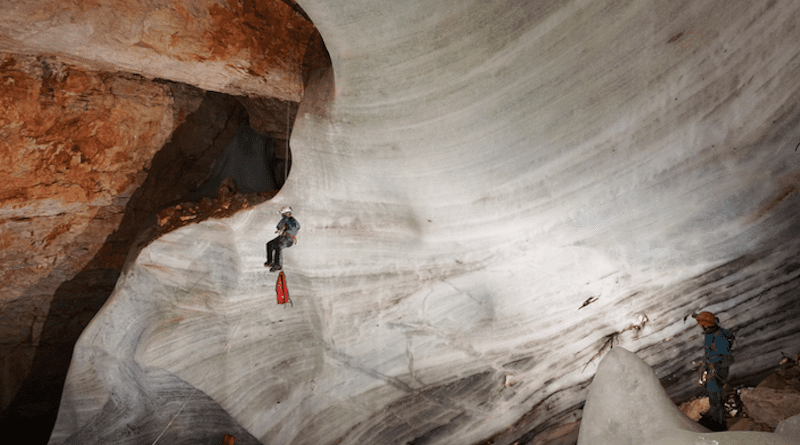Climate Change Threatens Ice Caves In Austria
There are several thousand documented ice caves worldwide, and Austria is one of the countries with the highest density of ice caves – but only a few have been studied in detail. Over the past few years, a team of researchers from the Universities of Innsbruck and Belfast has now analysed in detail eight ice caves with a descending morphology in Tyrol, Styria, Upper Austria and Carinthia, choosing a comparative research approach.
“There are already some good studies on single ice caves. However, this was the first time a comparative analysis was carried out and we focused on the ice development in several caves that are also in comparable settings: similar altitude and a steep to vertically sloping geometry,” explains Tanguy Racine from the Quaternary Research Group around Christoph Spötl at the Department of Geology. His dissertation dealt with the topic in detail. Ice bodies in these caves are formed from solid precipitation: snow falls and slides into the cave in winter and then subsequently turns to ice at low temperatures.
Similar development of ice caves and glaciers
Using the radiocarbon method, the team determined the age of the ice layers in the caves, which are often many metres thick: “To date the ice, we focused on the tiniest inclusions of wood in the ice layers. The age of these wood fragments, which fell into the caves from the outside, can be determined precisely,” Tanguy Racine explains the procedure.
The large database of a total of 107 dates of wood inclusions from the ice draws an accurate picture of the increase and decrease of ice in the ice caves – the so-called mass balance – and this over a period of up to 2000 years in the past. This approach enabled the team to prove the hypothesis that historically documented glacier advances, such as during the “Little Ice Age”, are also represented in the increase in ice mass in ice caves and coincide in time.
“We can document comparable ups and downs in the development of ice in ice caves and glaciers for the period of the last two millennia. For both, it is essential how much snow falls in winter and how warm the summers are. The results also show us that a large part of the underground ice in Austria originates from the “Little Ice Age” between about the 15th and 19th centuries,” says the geologist.
Massive declines in the last decades
In the recent past, the balance of ice caves is clearly negative: “Glaciers are not alone in showing an above-average negative mass balance especially in the last decades. Ice caves have also been severely affected by the consequences of rising temperatures and declining precipitation,” says Tanguy Racine. “We are seeing a rate of ice retreat that has not been observed in any period in our measurement period over the last 2000 years. To give a few examples: Monitoring in the Guffert Eisschacht in Steinberg am Rofan showed a decline of almost three metres in the snow surface between 2019 and 2021, while Eisgruben Eishöhle at Sarstein in Upper Austria has lost 10 metres of ice thickness within 40 years. The ice loss in Kraterschacht in the Sengsen Mountains of Upper Austria is 20 metres in 20 years.”
The explanation for this development, analogous to the glaciers, is human-induced climate change.
“Especially for the medium-sized and smaller ice caves, we have to assume that they will massively lose ice mass or even become completely ice-free in the next few years to decades,” Racine clarifies. “The clock is ticking loudly.”
The Innsbruck researchers plan to selectively take ice cores from alpine ice caves in the coming years and store them cooled in order to preserve the valuable climate information for science in the long term.
The studied Austrian caves are:
Tyrol: Hundsalm Eis- und Tropfsteinhöhle; Guffert Eisschacht
Styria: Bärenloch Eishöhle; Tremml-Schacht
Upper Austria: Eisgruben Eishöhle; Kraterschacht; Hochschneid Eishöhles
Carinthia: Großer Naturschacht

